
The Downtown Eastside (DTES) is a neighbourhood in Vancouver, British Columbia, Canada. The area, one of the city's oldest, is the site of a complex set of social issues including extremely high levels of drug use, homelessness, poverty, crime, mental illness, and prostitution. It is also known for its strong community resilience and history of social activism.
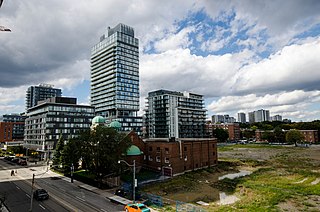
Regent Park is a neighbourhood located in downtown Toronto, Ontario, built in the late 1940s as a public housing project managed by Toronto Community Housing. It sits on what used to be a significant part of the Cabbagetown neighbourhood and is bounded by Gerrard Street East to the north, River Street to the east, Shuter Street to the south and Parliament Street to the west. Regent Park's residential dwellings, prior to the ongoing redevelopment, were entirely social housing, and covered all of the 69 acres (280,000 m²) which comprise the community. The original neighbourhood was razed in the process of creating Regent Park. The nickname Cabbagetown is now applied to the remaining historical, area north and west of the housing project, which has experienced considerable gentrification since the 60s and 70s.

Riverdale is a large neighbourhood in Toronto, Ontario, Canada. It is bounded by the Don River Valley to the west, Danforth Avenue and Greektown to the north, Jones Avenue, the CN/GO tracks, Leslieville to the east, and Lake Shore Boulevard to the south.

Queen Street is a major east-west thoroughfare in Toronto, Ontario, Canada. It extends from Roncesvalles Avenue and King Street in the west to Victoria Park Avenue in the east. Queen Street was the cartographic baseline for the original east-west avenues of Toronto's and York County's grid pattern of major roads. The western section of Queen is a centre for Canadian broadcasting, music, fashion, performance, and the visual arts. Over the past twenty-five years, Queen West has become an international arts centre and a tourist attraction in Toronto.

The Henry Street Settlement is a not-for-profit social service agency in the Lower East Side neighborhood of Manhattan, New York City that provides social services, arts programs and health care services to New Yorkers of all ages. It was founded under the name Nurses' Settlement in 1893 by progressive reformer and nurse Lillian Wald.
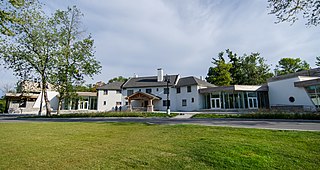
Guildwood, also known as Guildwood Village, is a residential neighbourhood in Scarborough, Toronto, Ontario, Canada. It is located along the Scarborough Bluffs, south of Kingston Road, from Grey Abbey Trail in the east.

The Broadview Hotel is a 58 room boutique hotel in Toronto, Ontario, Canada. It is located at the intersection of Broadview Avenue and Queen Street East in Toronto's Riverside neighbourhood. Built in 1893, the building was originally a hall with retail and office space and later converted into a hotel. Until 2014, the establishment was occupied by the New Broadview House Hotel, a hotel and boarding house housing low-income persons with a strip club named Jilly's on its ground level. It was closed and converted to an up-scale establishment with several restaurants and a roof patio.

So Others Might Eat (SOME) is a nonprofit organization which seeks to help deal with poverty in Washington, D.C.. SOME provides food, clothing, and healthcare services to the poor and homeless. In addition, SOME provides job training, counselling, and low-cost housing, and other services to "break the cycle of homelessness".

Lenox Hill Neighborhood House is a multi-service community-based organization that serves people in need on the East Side of Manhattan and on Roosevelt Island. Founded in 1894 as a free kindergarten for the children of indigent immigrants and as one of the first settlement houses in the nation, Lenox Hill Neighborhood House is the oldest and largest provider of social, legal and educational services on Manhattan's Upper East Side. Each year, they assist thousands of individuals and families who range in age from 3 to 103, represent dozens of races, ethnicities and countries of origin and "live, work, go to school or access services" on the East Side from 14th Street to 143rd Street and on Roosevelt Island. Their clients include indigent families and the working poor who live in the East Side's housing projects and tenements or who travel to the Upper East Side to work in low-wage jobs such as cashiers, housekeepers, nannies and laborers; 10,000 seniors; and hundreds of mentally ill homeless and formerly homeless adults. They have five locations between 54th and 102nd Streets, offer programs at dozens of East Side locations; their headquarters is located on East 70th Street.

East Toronto was an incorporated community, currently part of Toronto, Ontario, Canada. It covered much of the present day neighbourhood of the Upper Beaches, stretching up to Danforth Avenue in the north, part of it stretching to Lake Ontario in the south a portion of the present-day neighbourhood, The Beaches. The central street in East Toronto was Main Street, running between Danforth Avenue to Kingston Road. The commercial center of the town was located at the intersection of Main Street and Lake View Avenue. Following the annexation of East Toronto into Old Toronto, Main Street retained its name despite Toronto's conceptual Main Street being historically designated to be Yonge Street.
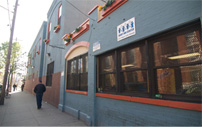
The Shelterhouse is a non-profit agency serving homeless individuals in Cincinnati, Ohio. Their stated mission is to be a "community of residents, staff and volunteers working together to provide basic human services for men & women experiencing homelessness with a primary commitment to shelter."
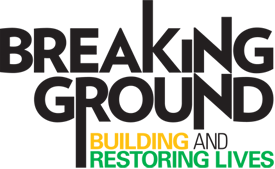
Breaking Ground, formerly Common Ground, is a nonprofit social services organization in New York City whose goal is to create high-quality permanent and transitional housing for the homeless. Its philosophy holds that supportive housing costs substantially less than homeless shelters — and many times less than jail cells or hospital rooms, and that people with psychiatric and other problems can better manage them once they are permanently housed and provided with services. Since its founding in 1990 by Rosanne Haggerty, the organization has created more than 5,000 units of housing for the homeless. "This is about creating a small town, rather than just a building," according to Haggerty. "It's about a real mixed society, working with many different people." Haggerty left the organization in 2011 to found Community Solutions, Inc. Brenda Rosen was promoted from Director, Housing Operations and Programs to Executive Director, and has led the organization since.

Homelessness is defined as living in housing that is below the minimum standard or lacks secure tenure. People can be categorized as homeless if they are: living on the streets ; moving between temporary shelters, including houses of friends, family and emergency accommodation ; living in private boarding houses without a private bathroom or security of tenure. The legal definition of homeless varies from country to country, or among different jurisdictions in the same country or region. According to the UK homelessness charity Crisis, a home is not just a physical space: it also provides roots, identity, security, a sense of belonging and a place of emotional well being. United States government homeless enumeration studies also include people who sleep in a public or private place not designed for use as a regular sleeping accommodation for human beings.People who are homeless are most often unable to acquire and maintain regular, safe, secure and adequate housing due to an unsteady or lack of income. Homelessness and poverty are interrelated. There is no methodological consent on counting the homeless and identifying their special needs; thus in most cities only estimated homeless populations are known.

Cass Community Social Services, Inc. is a nonprofit, 501(c)(3) community-based organization headquartered in Detroit, MI serving Southeastern Michigan, Wayne County, under the direction of a volunteer Board of Directors. Cass Community Social Services has occasionally engaged In acts of political activism, usually In protest of city and state budget cuts.
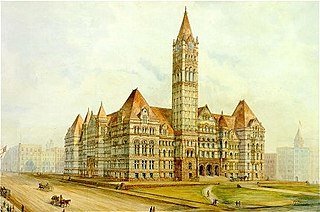
Throughout its history, Toronto has been a city divided into many districts and neighbourhoods. As the city has grown, new neighbourhoods have been created by expansion of the city into the countryside. Over time, the neighbourhoods within existing areas have also been altered and rearranged.
Launch Housing is based in Melbourne (Australia) and has been providing various services to people experiencing homelessness. It started operations in 1964 at Hanover Street in Fitzroy, and took on the name Hanover; the same as the street. It has 7 offices in Melbourne providing different services such as housing support, employment services, and various other support services to people experiencing homelessness. It's an independent and non-profit organisation not affiliated with any religious group, institution or government. It is funded by private, corporate and government donors.
Homelessness in Vancouver, British Columbia, Canada is a social crisis that has been rapidly accelerating over the last decade. According to the United Nations, homelessness can either be relative or absolute. Absolute homelessness describes people living in absence of proper physical shelter. Relative homelessness describes people living in poor conditions of health or security, including an absence of both personal safety and steady income despite having physical shelter to reside in. As of 2011, roughly 2,651 people in Vancouver are subject to one of these types of homelessness, or are transitioning between them. Homelessness as a social issue in Vancouver originated from federal funding cuts to affordable housing. After market housing increased, the cost of housing became one of Vancouver's main causes of homelessness, alongside lack of income. The homeless population in Vancouver is subjected to high amounts of crime-related victimization. There have been several approaches to reducing the homeless population in Greater Vancouver by the city and other organizations. As of 2011, the rate of homelessness in Vancouver has stopped increasing, but it is not being reduced either.

George Street is a north-south street in Toronto, Ontario, Canada from south of Front Street, north to Gerrard Street. Its southern blocks are within the grid of the townsite of the original town of York, Upper Canada. George Street was once one of the most exclusive and expensive addresses in the city. Today, the north end of the street, next to Seaton House men's shelter, is an example of urban blight. The City of Toronto government is redeveloping the street with a new Seaton House institution focussed more on long-term care. Several abandoned buildings have been bought by the City and others have been expropriated to facilitate the redevelopment - the George Street Revitalisation Project.
Karen O’Shannacery is a Canadian homeless advocate. She is the former executive director of the Lookout Emergency Aid Society in Burnaby and co-founder of the BC Shelter Network.

















